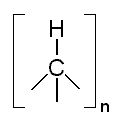Top Qs
Timeline
Chat
Perspective
Poly(hydridocarbyne)
Chemical compound From Wikipedia, the free encyclopedia
Remove ads
Poly(hydridocarbyne) (PHC) is one of a class of carbon-based random network polymers primarily composed of tetrahedrally hybridized carbon atoms, each having one hydride substituent, exhibiting the generic formula [HC]n. PHC is made from bromoform, a liquid halocarbon that is commercially manufactured from methane. At room temperature, poly(hydridocarbyne) is a dark brown powder. It can be easily dissolved in a number of solvents (tetrahydrofuran, ether, toluene etc.), forming a colloidal suspension that is clear and non-viscous, which may then be deposited as a film or coating on various substrates. Upon thermolysis in argon at atmospheric pressure and temperatures of 110 °C to 1000 °C, decomposition of poly(hydridocarbyne) results in hexagonal diamond (lonsdaleite).
More recently poly(hydridocarbyne) has been synthesized by a much simpler method using electrolysis of chloroform (May 2008)[1] and hexachloroethane (June 2009).[2]
The novelty of PHC (and its related polymer poly(methylsilyne)) is that the polymer may be readily fabricated into various forms (e.g. films, fibers, plates) and then thermolyzed into a final hexagonal diamond ceramic.
Remove ads
See also
- Carbyne, for name origin
References
External links
Wikiwand - on
Seamless Wikipedia browsing. On steroids.
Remove ads

